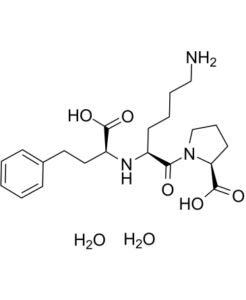This product is for research use only, not for human use. We do not sell to patients.

| Size | Price | Stock |
|---|---|---|
| 10g | $445 | Check With Us |
| 25g | $845 | Check With Us |
| 50g | $1265 | Check With Us |
Cat #: V20083 CAS #: 83915-83-7 Purity ≥ 98%
Description: Lisinopril hydrate (MK-521), an enalapril analog, is a potent angiotensin-converting enzyme (ACE) inhibitor used in treatment of hypertension, congestive heart failure, and heart attacks, and also in preventing renal and retinal complications of diabetes.
Publications Citing InvivoChem Products
Product Promise

- Physicochemical and Storage Information
- Protocol
- Related Biological Data
- Stock Solution Preparation
- Quality Control Documentation
| Molecular Weight (MW) | 441.52 |
|---|---|
| Molecular Formula | C21H35N3O7 |
| CAS No. | 83915-83-7 |
| SMILES Code | O=C(O)[C@H]1N(C([C@H](CCCCN)N[C@H](C(O)=O)CCC2=CC=CC=C2)=O)CCC1.[H]O[H].[H]O[H] |
| Synonyms | MK-521; MK521; MK 521; Lisinopril dihydrate; Prinivil; Qbrelis; Ranolip |
| Protocol | In Vitro | Lisinopri dihydrate is a potent, competitive inhibitor of angiotensin-converting enzyme (ACE), the enzyme responsible for the conversion of angiotensin I (ATI) to angiotensin II (ATII). ATII regulates blood pressure and is a key component of the renin-angiotensin-aldosterone system (RAAS). Lisinopril may be used to treat hypertension and symptomatic congestive heart failure, to improve survival in certain individuals following myocardial infarction, and to prevent progression of renal disease in hypertensive patients with diabetes mellitus and microalbuminuria or overt nephropathy |
|---|
| Solvent volume to be added | Mass (the weight of a compound) | |||
|---|---|---|---|---|
| Mother liquor concentration | 1mg | 5mg | 10mg | 20mg |
| 1mM | 2.2649 mL | 11.3245 mL | 22.6490 mL | 45.2981 mL |
| 5mM | 0.4530 mL | 2.2649 mL | 4.5298 mL | 9.0596 mL |
| 10mM | 0.2265 mL | 1.1325 mL | 2.2649 mL | 4.5298 mL |
| 20mM | 0.1132 mL | 0.5662 mL | 1.1325 mL | 2.2649 mL |
This equation is commonly abbreviated as: C1 V1 = C2 V2
- (1) Please be sure that the solution is clear before the addition of next solvent. Dissolution methods like vortex, ultrasound or warming and heat may be used to aid dissolving.
- (2) Be sure to add the solvent(s) in order.




































